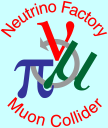 |
Introduction to the Muon Collider Study Group |
|
 |
Introduction to the Muon Collider Study Group |
|
In order to understand the most basic structure of matter and energy, an advance in the energy frontier of particle accelerators is required. Accelerators are the instruments of choice by scientists engaged in particle physics research. Advances in high energy particle physics have been, and are expected to continue to be, dependent on and paced by advances in accelerator facilities.
High energy accelerators and detectors are the light sources and microscopes used to look inside of elementary particles, allowing us to ask deeper questions than ever before: what is the origin of mass?, how did the fundamental particles and forces work together to produce the world around us today?
The majority of contemporary high-energy physics experiments utilize colliders. Colliders are machines that accelerate and guide oppositely directed and tightly focused beams of particles into collision at the intersection point (IP); where enormous amounts of energy are released, creating the conditions, we believe, that occurred during the first moment of our universe.
Operating accelerators generally fall into two classes: hadron accelerators and electron accelerators. In the 50's Tinlot discussed muon storage rings and in the 70's muon colliders were proposed by Skrinsky and Neuffer, but the luminosities were relatively low. In the last two years a renew interest in the idea arose and significant advances in pion capture and cooling has risen the luminosity to levels comparable to those of hadrons or electron machines.
In general terms, the physics that could be studied with a muon-muon collider would be similar to that with an electron-positron machine (Linear Collider). Muons are just heavy electrons (200 times heavier than an electron), but, because of their larger mass, produce much less synchrotron radiation.
We can list at least three advantages for using muons instead of electrons:
Additional advantages are:
However, there are serious technological challenges to building a muon collider. Firstly, although smaller, there are no guarantees that it would be cheaper. Secondly, it is not completely obvious that the required luminosity L = 1035 cm-2s-1 is achievable.
Of utmost concern are the decays of the muons into electrons and neutrinos. The electrons will have lower energy than the muons and will not be trapped in the ring. They will synchrotron radiate, spreading photons on to the outer wall of the ring, and simultaneously will spiral inward hitting the inner wall of the ring, making a large amount of undesirable radiation. This is a problem for superconducting magnets around the ring. It is also a major concern for the detector, complicating the ability of the physics users to isolate and understand the interesting interactions, such as the production of high mass particles (Higgs bosons?) created at the intersection point. For an schematic of the collider ring click here. A possible complete layout of the muon collider is shown here.
Our present mailing list includes collaborators from BNL, FNAL, LBL and other institutions. If you wish to be included please send e-mail to Juan C. Gallardo
J. Scott Berg <jsberg@bnl.gov>
6 September 2000.